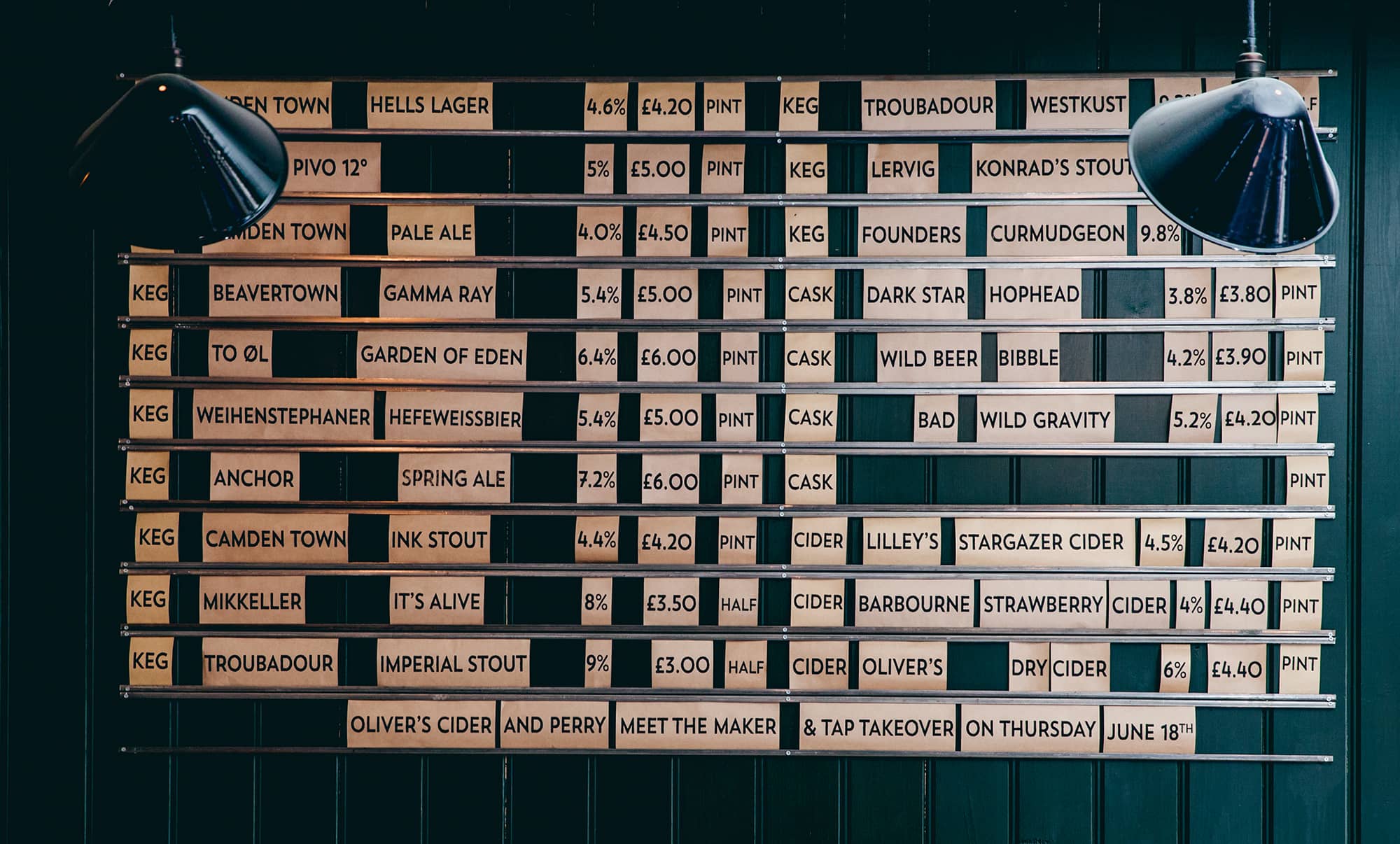Brown, Belgian, bitter & strong

Brown ales are malty, mahogany-coloured and deep. Belgian beer is often fruity with distinctive yeast strains and a light body but high alcohol content. English bitter is easygoing and light on hops. Strong ales have heavy grain bills for high ABV and warming alcohol.
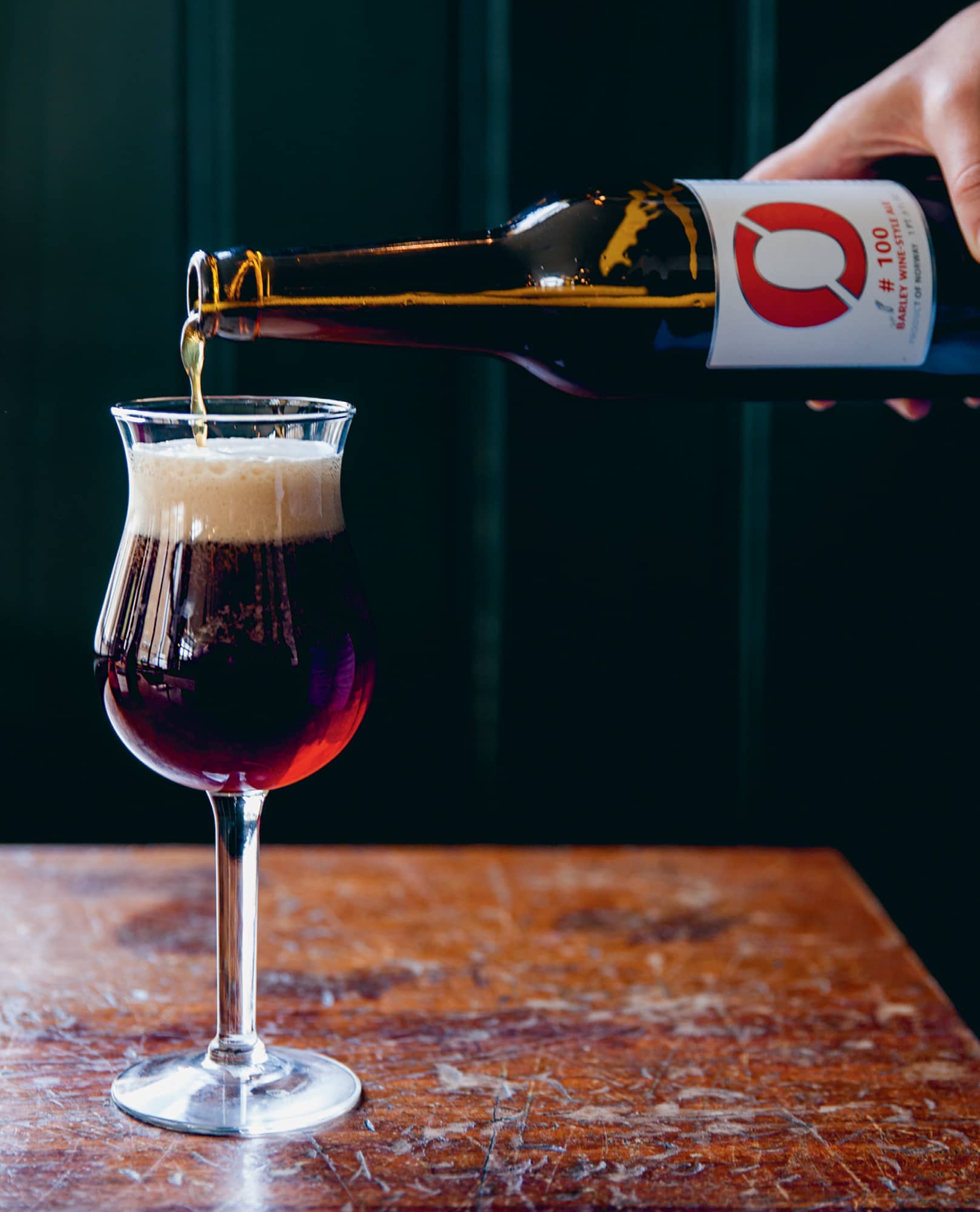
◁ Nøgne Ø
Grimstad, Norway
#100
BARLEYWINE

20 L / 5 GAL | ABV 10.1%
OG 1.092 | FG 1.015
The first commercial barleywine was Bass No 1 in 1903. More than 100 years later, Nøgne Ø has created its own version, and it’s a worthy successor to the Burton upon Trent trailblazer. When made well barleywine stands shoulder-to-shoulder with the grand vintages of Bordeaux, but it’s challenging to make. It’s difficult to work with such a large volume of grist, and to get all the desired sugars out. The grain bed will be heavy, making filtering tough. If you don’t hit the OG then the ABV won’t be high enough and you simply won’t have barleywine. This is an occasion when bumping the pre-fermentation OG up with malt extract is not a bad idea, should you need to. Other methods to ensure a strong barleywine include making two smaller worts then combining. Plus, yeast is key: without proper attenuation, you’ll be left with a super-sweet and undrinkable syrup. A liquid yeast is advisable, probably two packs’ worth. It’s also best to rack it off the yeast after primary fermentation has finished, then again after three or four weeks, before thinking about priming and bottling. Nothing about barleywine can be rushed.
GRAIN
Maris Otter, 6.85kg/15lbs 1.6oz (88%)
Wheat malt, 800g/1lb 12.2oz (10%)
Chocolate malt, 160g/5.64oz (2%)
MASH
63C/145F for 90 mins
HOPS
Chinook, 70g/2.5oz, 90 mins
Centennial, 50g/1.8oz, 15 mins
Centennial, 50g/1.8oz, 5 mins
Columbus, 50g/1.8oz, 0 mins
Chinook, 50g/1.8oz, dry hop
YEAST
White Labs WLP007 Dry English Ale or Danstar Nottingham Ale
FERMENT
20C/68F
SPECIAL INSTRUCTIONS
This is a beer for the future. It needs long and gentle bottle ageing to reach full potential. (Even carbonation will take one or two months.) Six months’ rest isn’t an exaggeration; longer will be even better. Store the bottles somewhere dark and peaceful, and open one now and again to appreciate the developing characteristics
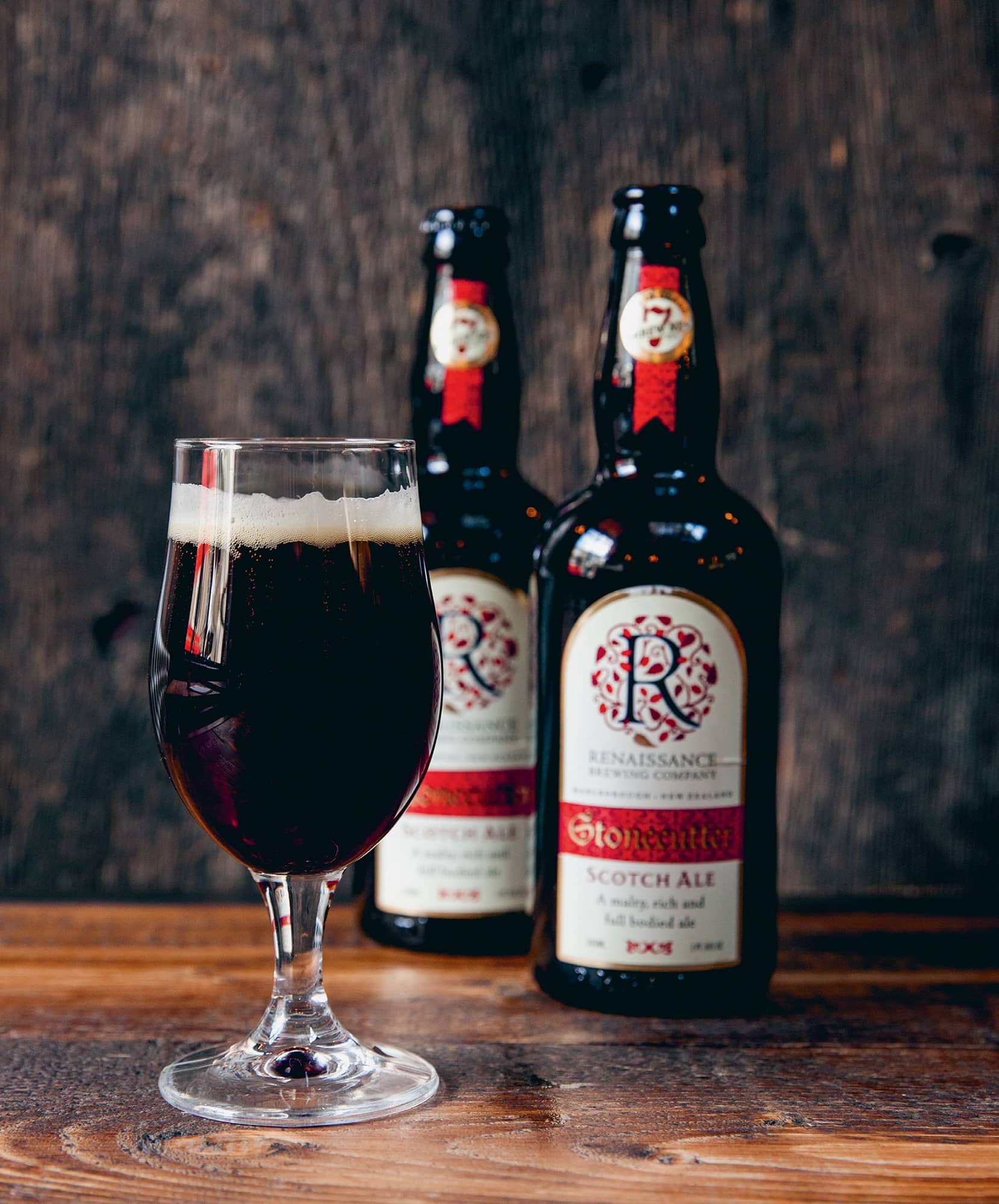
◁ Renaissance Brewing
Blenheim, New Zealand
STONECUTTER SCOTCH ALE
SMOKED SCOTCH ALE

20 L / 5 GAL | ABV 7%
OG 1.074 | FG 1.021
Marlborough, at the northern tip of New Zealand’s South Island, is winemaking country. All that viticulture is thirsty work, but luckily the award-winning Renaissance is on hand to give those toiling farmers something decent to drink. Like many New World beers, Stonecutter takes its inspiration from a classic European style – in this case, the Scottish ‘wee heavy’, a strong, hearty ale originally from Edinburgh. Malts are in charge here – nine varieties provide roasty, toasty, chocolate-and-toffee complexity, and the smoked malt, even in a tiny proportion, floats up in a delicate wisp. But this being New Zealand, locally grown hops feature too. Stonecutter is a big, big beer, and will gladly rest on wood for a while to let its flavours develop: Renaissance head brewer Andy Deuchars recommends oak chips, 15g/0.5oz, in the fermenter for three to five weeks. Put them in a sterilised bag and add to secondary, from where you can sample the beer every week or so to check how much oakiness the beer has taken on. This is a good method for those who don’t have a barrel.
GRAIN
Pale ale malt, 2.5kg/5lbs 8.18oz (68%)
Amber malt, 500g/1lbs 1.6oz (6.8%)
CaraAmber, 500g/1lbs 1.6oz (6.8%)
Biscuit malt, 250g/8.8oz (3.5%)
Medium crystal malt, 250g/ 8.8oz (3.5%)
Pale crystal malt, 250g/8.8oz (3.5%)
Vienna malt, 250g/8.8oz (3.5%)
Wheat malt, 250g/8.8oz (3.5%)
Smoked malt, 60g/2.1oz (0.9%)
MASH
Mash at high temperature to get the required attenuation, 68C/154.4F, 60 mins
HOPS
(60 minute boil)
Southern Cross 14% AA, 20g/ 0.7oz, first wort hops
Pacific Jade, 16g/0.6oz, hopback or whirlpool
YEAST
Wyeast 1968 London Ale
FERMENT
20C/68F
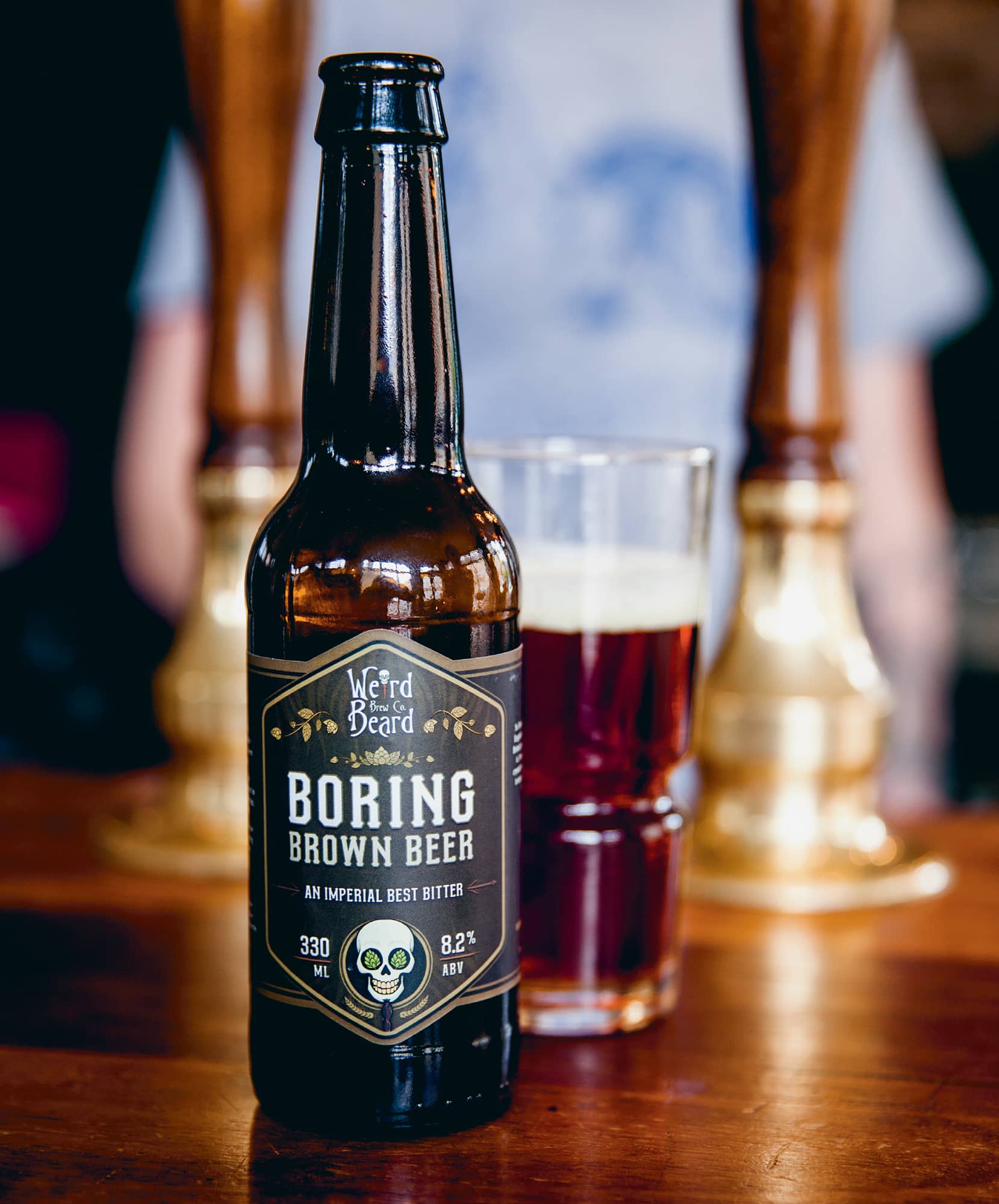
◁ Weird Beard Brew Co
Hanwell, London, England
BORING BROWN BEER
IMPERIAL BEST BITTER

20 L / 5 GAL | ABV 7.2%
OG 1.069 | FG 1.013
The ‘boring brown beer’ of the name is supposedly craft beer’s absolute antithesis: interchangeably conservative beers served in pubs up and down the land, offering drinkers zero excitement and zero adventure. Weird Beard’s Boring Brown Beer, however, is anything but boring. It’s a range of American-style brown ales or ‘imperial best bitters’ featuring a single hop to impressive effect – here it’s the turn of Chinook, which brings enough herbal aroma, spice and even grapefruit to stand up to the dark caramel of the Special B malt. Two malts, one hop, loads of character – it’s a simple recipe, but leaves nowhere to hide, and your brewing techniques have to be sound. Weird Beard is another inspiration for homebrewers: founders Gregg and Bryan started brewing professionally after years of amateur experimentation. Their hirsute skull logo adorns every bottle label, from the Little Things That Kill 3.8% hop-heavy session ale to the Sadako barrel-aged imperial stout. ‘No gimmicks, no crap and never knowingly underhopped’ is the slogan: a mantra we could all take to heart.
GRAIN
Pale malt, 5.3kg/11lbs 11oz (84%)
Special B malt, 1.1kg/2lbs 6.8oz (16%)
MASH
64C/147F for 75 mins
HOPS
Chinook 13%AA, 50g/1.8oz, 60 mins
Chinook 13%AA, 20g/0.7oz, 30 mins
Chinook 13%AA, 20g/0.7oz, 15 mins
Chinook, 13%AA, 20g/0.7oz, 0 mins
YEAST
White Labs WLP007 Dry English Ale
FERMENT
19C/66F for 4 days primary, 10 days secondary
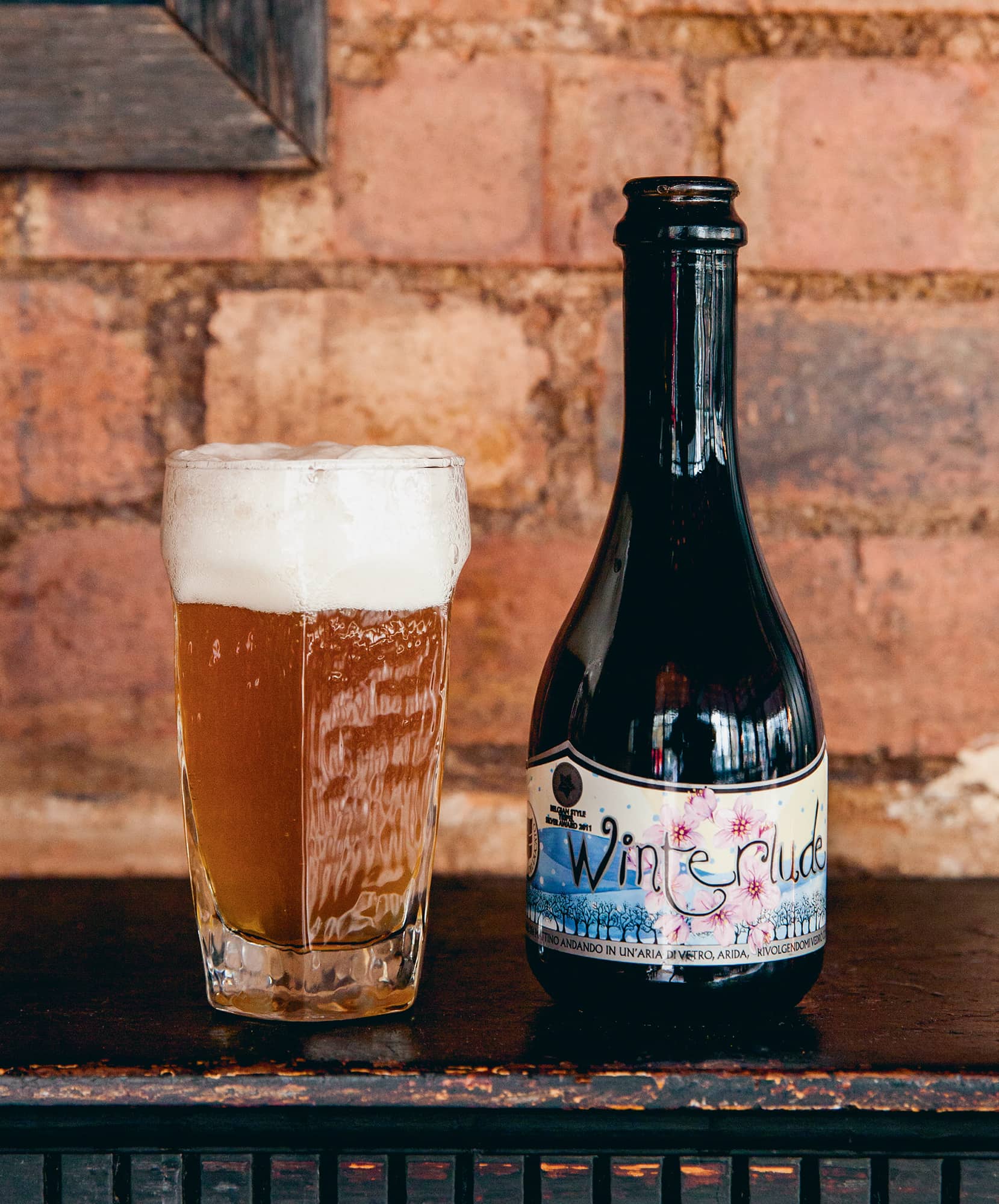
◁ Birrificio del Ducato
Soragna, Emilia-Romagna, Italy
WINTERLUDE
TRIPEL

20 L / 5 GAL | ABV 8.8%
OG 1.079 | FG 1.012
For a beer to be certified Trappist, it must be made by one of a select few monasteries (mostly in Belgium, although there are others in the Netherlands, Italy and even Massachussets), and all profits from sale must go to charitable causes. Tripel is a strong pale ale from the Low Countries and a classic Trappist brew: devotion to an abstemious life is not required to make or drink Del Ducato’s delightful Winterlude, although with its classic European hops, Belgian yeast and candi sugar, it’s faithful to the style. Kaleidoscopes of complex flavours come from these simple ingredients. Giovanni Campari’s brewery, in the town of Soragna near Parma, creates beers with an elemental link to the land and heartfelt stories behind their inception: “Winterlude is a tribute to a friend who went missing, who we may meet again one day, just like the sun that is hiding behind the hill.” This is a beer to age – tripels benefit from a secondary fermentation off the yeast and then a couple of months in the bottle, when it can be savoured with all the lip-smacking and pontification associated with a fine wine.
GRAIN
Pilsner malt, 5.95kg/13lbs 1.9oz (86.5%)
Acidulated malt, 290g/10.2oz (4%)
Carapils, 190g/6.7oz (3%)
MASH
66C/152F for 60 mins
HOPS
Herkules, 4g/0.14oz, 70 mins
Marynka, 13g/0.45oz, 5 mins
Whitbread Goldings Variety, 25g/0.9oz, 0 mins
YEAST
Wyeast 3787 Trappist High Gravity
FERMENT
20C/68F
OTHER INGREDIENTS
White candi sugar, 450g/15.9oz (6.5%), added during the boil. Stir till it’s properly dissolved to avoid it burning on the kettle
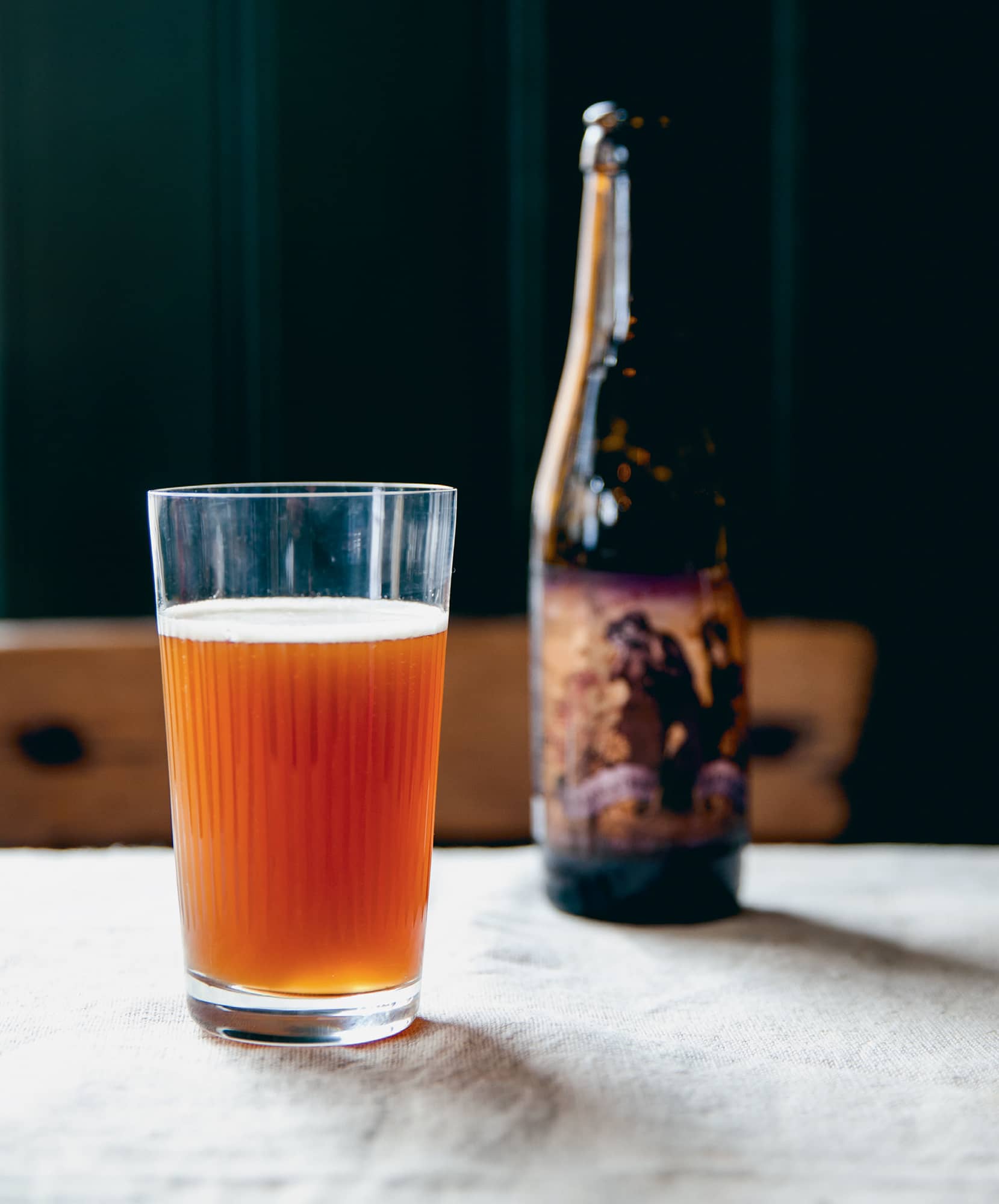
◁ Stillwater Artisanal
Baltimore, Maryland, and Brooklyn, New York, USA
OF LOVE & REGRET
BOTANICAL FARMHOUSE ALE

20 L / 5 GAL | ABV 7%
OG 1.058 | FG 1.004
Of Love & Regret (also the name of the Stillwater Artisanal bar in the Brewers Hill district of Baltimore, Maryland) is described as a ‘botanical farmhouse ale’, and it doesn’t need to be pigeonholed beyond that. From the first sip you’ll realise this is no ordinary brew. Belgian beers often have spices, fruits and natural additions, and this is a particularly inventive take on that tradition. The heather, camomile, dandelion and lavender steeped in the boil add subtle garden flavours as they intertwine with the grassy, spicy Sterling and Styrian Golding: imagine a Low Countries hop field overgrown with summer wildflowers and you’re somewhere near the intensely floral character of this beer. The French saison yeast brings out the herbal notes and provides the high attenutation needed for a dry finish. Aromatic malt is a speciality grain which adds a distinctive maltiness and a deep copper colour (and there’s no substitute for it). These sort of open-interpretation Belgian ales really allow the imaginative brewer to become an artist. Get creative!
GRAIN
Pilsner malt, 4kg/8lbs 12oz (78%)
Wheat malt, 510g/1lb 2oz (10%)
Vienna malt, 510g/1lb 2oz (10%)
Belgian aromatic malt, 100g/ 3.5oz (2%)
MASH
63C/146F for 45 mins, 75C/167F for 15 mins
HOPS
Magnum 14% AA, 7g/0.25oz, 75 mins
Sterling 7.5%, 15g/0.53oz, 10 mins
Sterling, 28g/1oz, 0 mins
Styrian Golding, 14g/0.5oz, 0 mins
YEAST
Wyeast 3711 French Saison
FERMENT
Pitch at 23C/70F then allow to rise to 24C/75F. Crash cool when activity is complete
OTHER INGREDIENTS
Heather (Calluna vulgaris), 20g/0.7oz
Dandelion (Taraxacum officinale), 12g/0.42oz
Camomile (Matricaria chamomilla), 8g/0.28oz
Lavender (Lavandula × intermedia), 4g/0.14oz
At flameout, steep all botanicals in a mesh bag for 10 mins
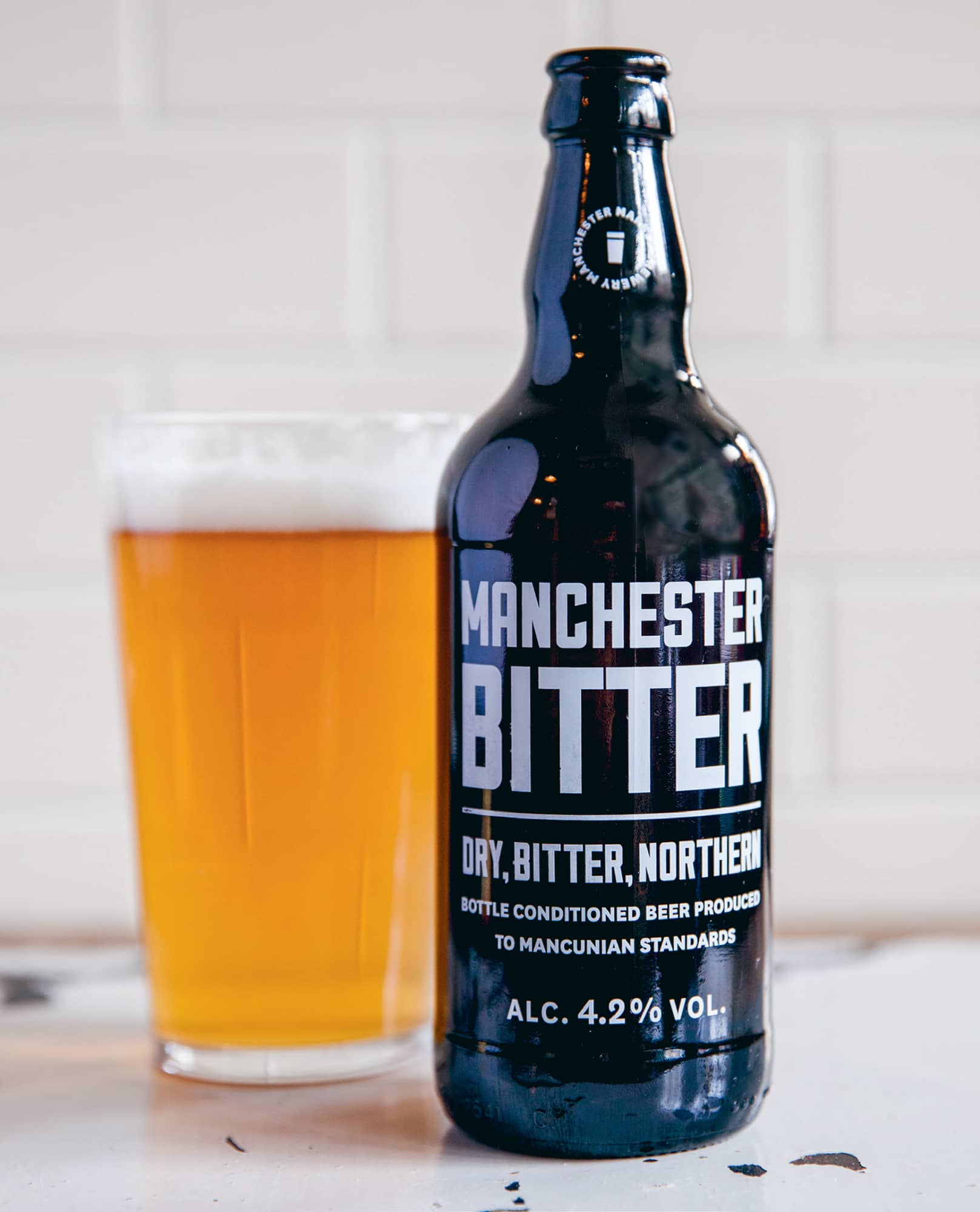
◁ Marble Brewery
Manchester, England
MANCHESTER BITTER
BITTER

20 L / 5 GAL | ABV 4.2%
OG 1.040 | FG 1.008
Manchester in the north of England is a proper brewing city, and Marble is Manchester through and through. It’s committed to cask as well as keg and bottle, and the no-nonsense Northern branding of its logo hints at the honest and sturdily dependable beers within. Almost every style of beer has left the brewery gates, from a German latzenbier to the bourbon-barrel-aged Russian Imperial Stout, but Marble also makes the traditional sort of ales that made the city great and fuelled the Industrial Revolution in the nineteenth century. So there’s the Best, English IPA, hearty Stouter Stout and Pint, an everyday bitter that really would be welcome every day. Plus the classic bitter-with-a-twist showcased here: it features the solid malt base you’d expect (Maris Otter with a smaller proportion of darker roasted crystal grains), but updates the hop bill with the Kiwi Waimea and Motueka, leaving a dry, slightly fruity and, of course, bitter finish. It’s a Mancunian classic up there with the Smiths, football rivalry and rain.
GRAIN
Maris Otter, 3.2kg/7lbs 0.9oz (94%)
Caramalt, 140g/4.9oz (4%)
Crystal malt 150L, 70g/2.5oz (2%)
MASH
66C/151F for 50 mins
HOPS
Herkules 16.1% AA, 3g/0.1oz, 70 mins
Goldings 3.4% AA, 20g/0.7oz, 15 mins
Waimea 18% AA, 25g/0.9oz, 0 mins (steep for 20 mins)
Motueka 8% AA, 25g/0.9oz, 0 mins (steep for 20 mins)
YEAST
Something very neutral and appropriate to the style
FERMENT
18-21C/64-70F
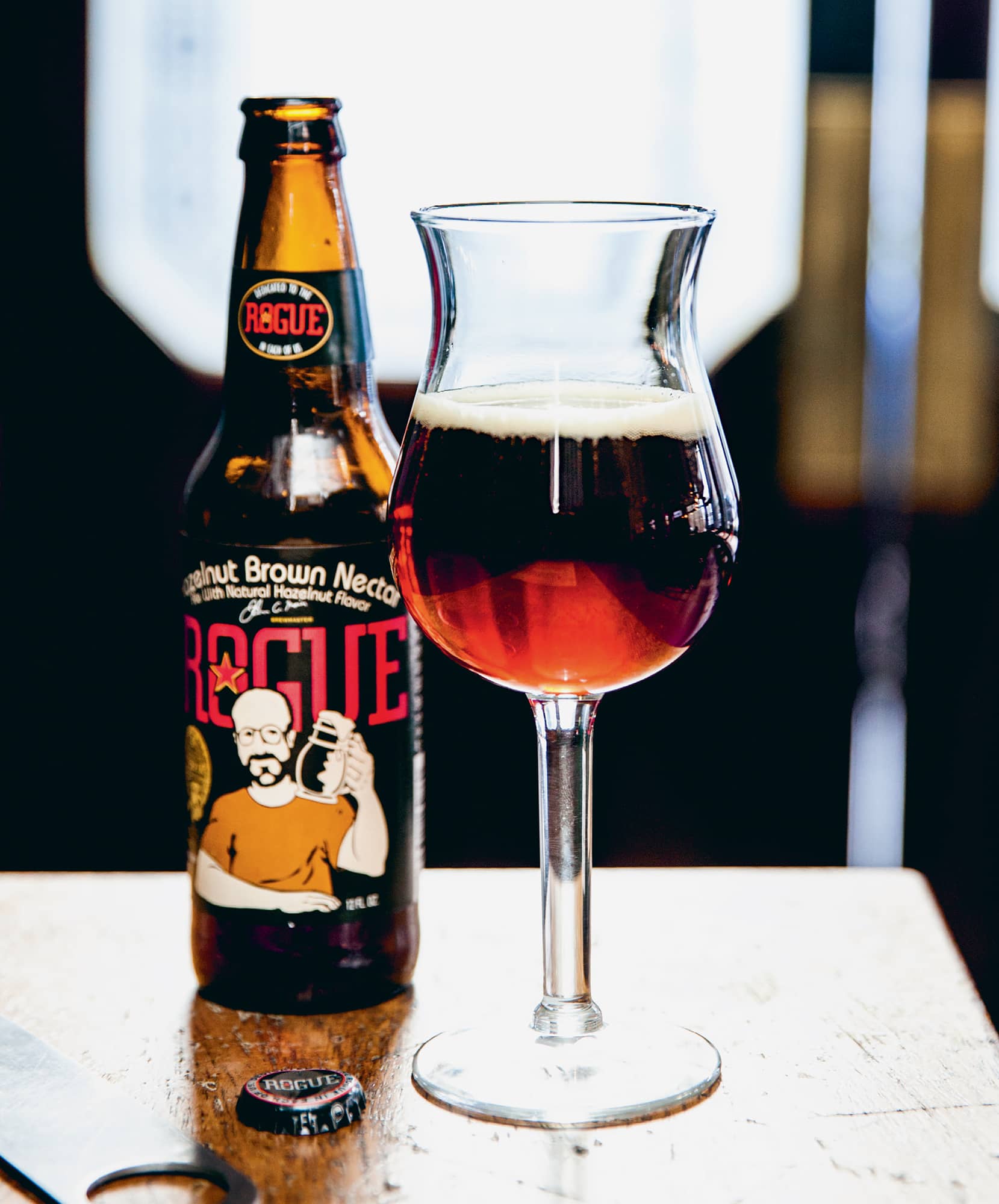
◁ Rogue Ales
Newport, Oregon, USA
HAZELNUT BROWN NECTAR
AMERICAN BROWN ALE

20 L / 5 GAL | ABV 6.2%
OG 1.057 | FG 1.016
Nut brown ale is a traditional English-style ale, the deep burnished colour of chestnuts, with a mildly nutty taste from a complex blend of roasted malts. What it doesn’t usually have is actual nuts in it, but Rogue’s classic Hazelnut Brown Nectar takes things to the next level with a delicate infusion of real nut extract (Northwestern’s high-quality flavourings mean the brewer can control exactly how much ‘nuttiness’ makes it into the beer). It also uses the Rogue strain Pacman yeast, which can be bought through Wyeast. The Oregon brewery has a history of pushing the boat out with its experimental yet always drinkable beers (Sriracha Hot stout with chilli sauce really works), but its standard range is anything but standard. Dead Guy Ale is undoubtedly the best-known heller bock in the USA (okay, probably the only known heller bock) and the Shakespeare oatmeal stout is a rated favourite the world over. Rogue also has its own farms in the Pacific Northwest growing ingredients for its brews (pumpkins, rye) as well as some that hopefully don’t make it anywhere near beer (turkeys, for instance).
GRAIN
Great Western 2-row pale malt, 3.5kg/7lbs 12oz (59%)
Great Western Munich malt 10L, 0.9kg/2lbs (15%)
Great Western Crystal malt 75L, 680g/1lb 8oz (11%)
Baird Brown malt, 312g/11oz (5%)
Great Western Crystal malt 15L, 255g/9oz (4%)
Great Western Crystal malt 120L, 255g/9oz (4%)
Franco-Belges Kiln Coffee malt, 113g/4oz (2%)
MASH
67C/152F for 60 mins
HOPS
(70 minute boil)
Perle pellets 9% AA, 17g/0.6oz, 60 mins
Sterling pellets 5%AA, 14g/0.5oz, 0 mins (ten-minute hop stand)
YEAST
Wyeast 1764 Pacman
FERMENT
16-18C/60-65F
OTHER INGREDIENTS
Northwestern hazelnut extract, 1/2 tsp, to be added at bottling stage
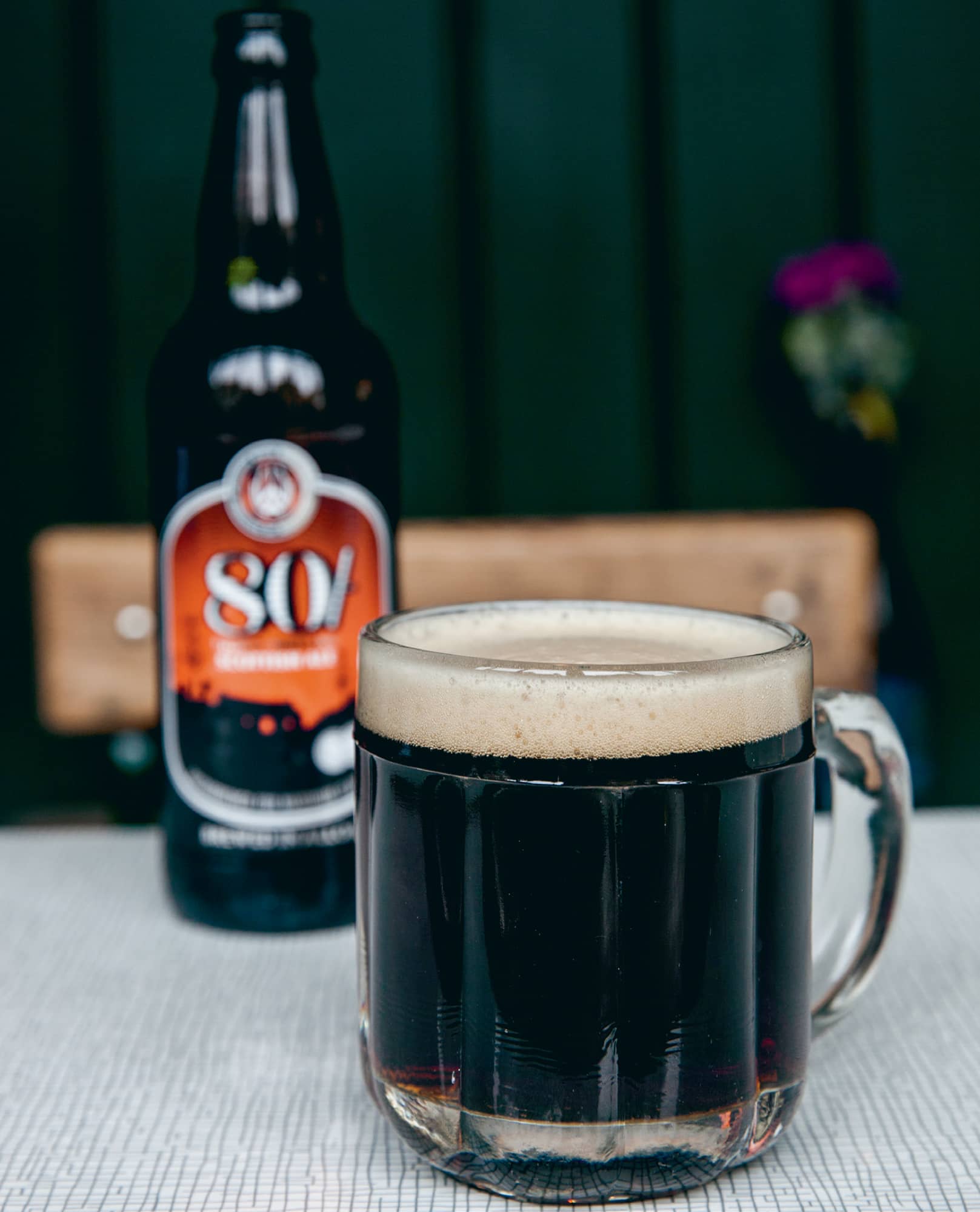
◁ Williams Bros Brewing Co
Alloa, Scotland
80/-
SCOTTISH ALE

20 L / 5 GAL | ABV 4.2%
OG 1.043 | FG 1.012
Scotch ale is known to most people worldwide as something strong, sweet-ish and richly mahogany in colour. It often has an embarrassing name like ‘Big Tam’s Kilt Lifter’. It’s not, unsurprisingly, what most Scots drink day-to-day. A more appropriate contender for a national pint would be 80 shilling (called ‘80 bob’ or even just ‘80’ by locals – it’s named after an old system of taxation on a barrel, whereby the strongest and best-quality beer commanded keener interest from the exciseman). Scott and Bruce Williams, based in the historical Central Belt brewing hub of Alloa, have done more than anyone to revive and maintain ancient Scottish styles; as well as their Fraoch heather ale, a resurrection of a beer that predated hop use by a good few centuries, is this updated 80/-. Its generous malts and English bittering hops are faithful to a traditional version, but then the Northwestern US aroma hops and orange peel infusion give it a modern flourish (although those ingredients still tread quietly – this is a malty beer). Drink with a slainte (Gaelic for cheers).
GRAIN
Pale malt, 2.87kg/6lbs 5oz (75%)
Wheat malt, 380g/13.4oz (10%)
Crystal malt 115L, 250g/8.8oz (6.5%)
Chocolate malt, 170g/6oz (4.5%)
Milled oats, 150g/5.3oz (4%)
MASH
70C/158F for 50 mins
HOPS
First Gold, 14.5g/0.5oz, 60 mins
Savinski Goldings, 11g/0.4oz, 45 mins
Amarillo, 10g/0.35oz, 0 mins
Cascade, 10g/0.35oz, dry hop
YEAST
White Labs WLP039 Nottingham Ale
FERMENT
20C/68F
OTHER INGREDIENTS
Sweet orange peel, 40g/1.4oz, boil for 15 mins
